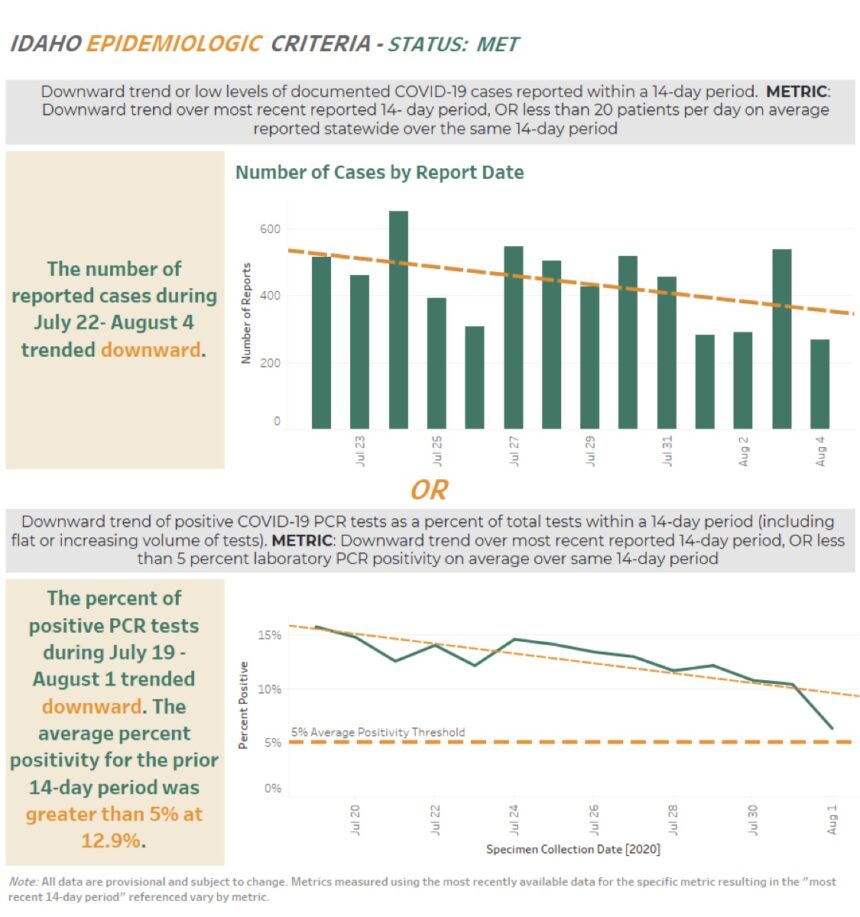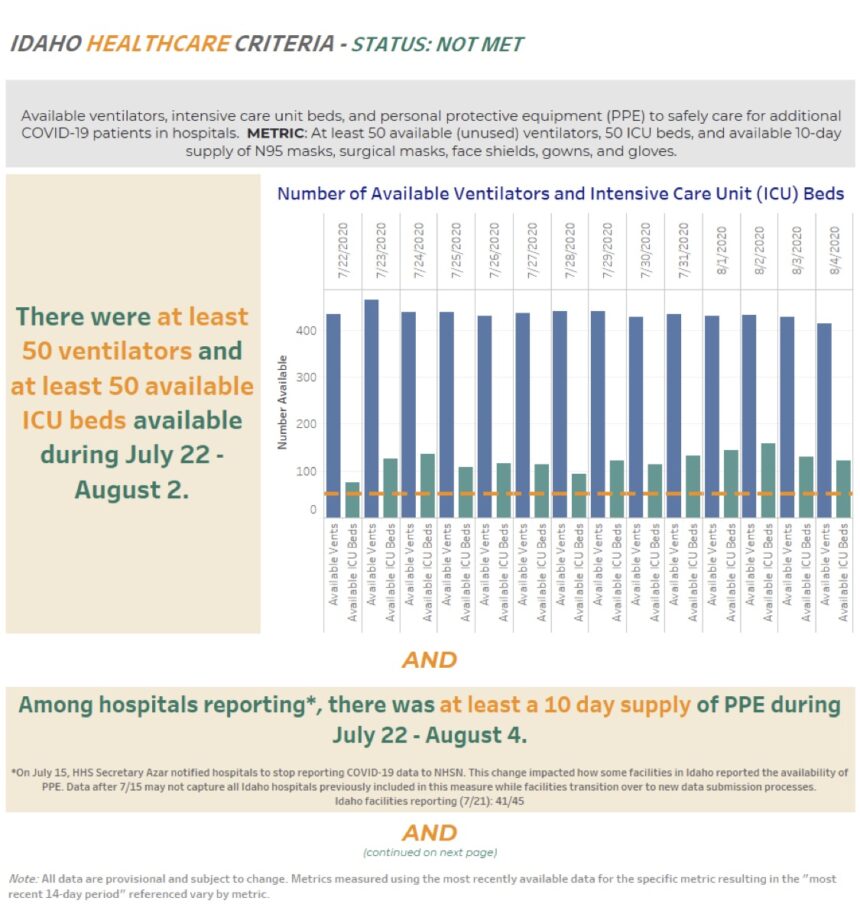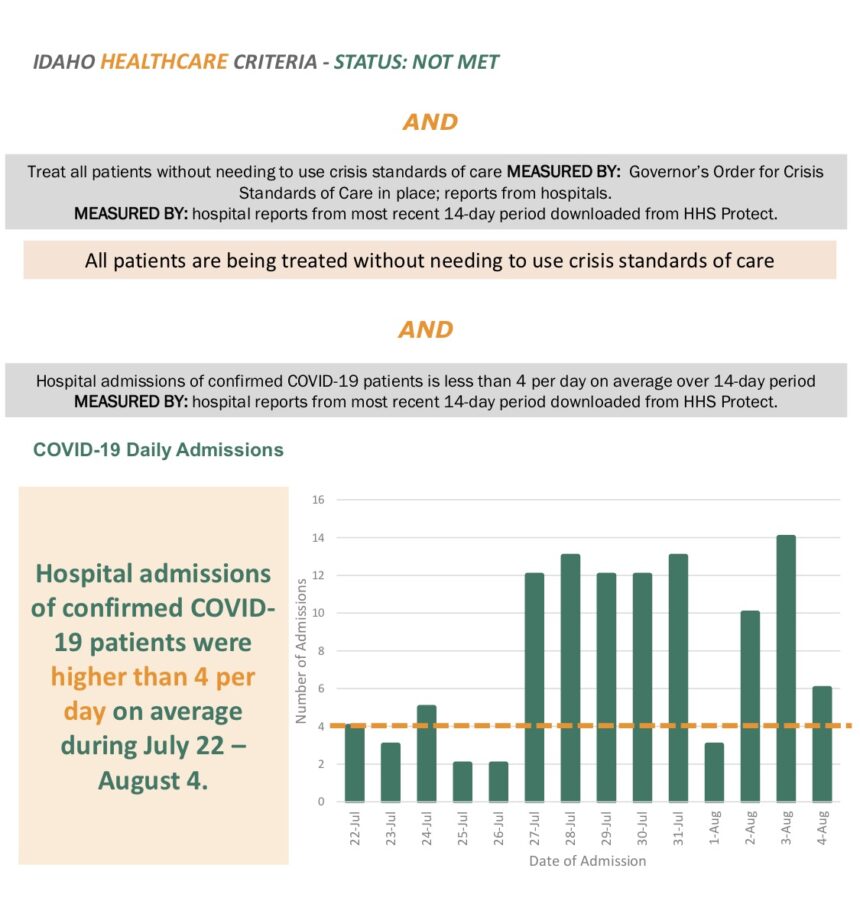Why Idaho is still in Idaho Rebounds Stage 4





IDAHO FALLS, Idaho (KIFI/KIDK) - Idaho State epidemiologist Dr. Christine Hahn said Thursday there are new metrics showing how widespread the virus is in Idaho. The metrics show how many people are severely sick and how hospitals are handling positive cases.
Currently, Idaho is showing a downward trend, but we are not where we need to be.
Hospitals are showing fewer emergency visits and less hospital admittance due to COVID-19. They have a sufficient supply of ICU beds and ventilators. Many hospitals have at least a 10 day supply of PPE on hand.
There hasn’t been a rise in hospital staff testing positive, and it is not a large number. Before, Idaho did not have timely information to monitor healthcare workers because the timing gap was too long between positive tests and reporting. Now, hospitals report everyday about staff shortages.
“It’s not about beds, it’s about having staff,” Dr. Hahn said. She noted Idaho is seeing better youth masking.
Idaho has not reached a crisis standard of care due to a lack of hospital resources. The number of daily admittance for confirmed cases should be below four per day.
Right now, Idaho is well-above that with 14 people recently admitted in one day.
This is an extremely important measure in the state’s metric system. When the patient numbers are rising, the pandemic needs to be taken seriously.
Dr. Hahn says due to the admittance levels, Idaho is staying in Stage 4.
Governor Little said moving out of Stage 4 will make a difference due to the message that Idaho is doing the right thing so the incident rate will go down. He said an unpredictable flu season approaching may impact hospital capacity levels.
As for a timeline for moving out of Stage 4, Governor Little said all areas of the state are at different levels and there are many unpredictable situations on the horizon, one of them being flu season and another being children returning to school in the fall. These scenarios may factor into future metrics that determine Idaho’s stage and tighten the gap between points.
State Board of Education Chairman Debbie Krichfield said the guidelines for reopening schools are left up to the local public health districts. She wants to see a higher level of support for students and teachers than the state offered in the spring.
The guidelines for reopening were intended to be different between school districts and it is part of the process in reopening. She says having a linear view of open or closed is not a good outlook. School districts are collaborating with health experts, hospitals, businesses, parents, and daycares to plan their own safe reopening. Education is a priority in the state of Idaho and the board of education is hoping for in-person learning to begin this fall. There are subgroups of education that need further planning such as technical colleges that require in lab learning and special needs education.
Superintendent Ybarra says kids are losing ground fast due to school closures. Their social and emotional well-being is also suffering due to the pandemic. Some children rely on school for nutritional meals. She says public health is a priority in planning school reopenings and they are prepared for multiple situations. She says the board of education is listening to the public when making decisions.
Due to the digital divide taskforce, schools are more prepared to pivot to online learning but this type of learning cannot replace the value of in-person education. She says schools are being responsible in planning safety measures for school reopenings. The governor has given $10 million to schools for PPE equipment. The plan is for every school district to have sanitizer, masks, and digital thermometers available. Governor Little said he will not block schools’ decision to extend school closures but these decisions are left up to trustees, boards, and superintendents. He said school districts will have a better idea about the need to push back school reopenings in two weeks.
One community concern involves the lack of resources for online learning, saying the largest school district does not have enough computers and some schools are not prepared to offer online or blended learning options this fall. Governor Little said $136 million in school funding was intended and encouraged for spending on technology. He says this divide comes from local control and not the lack of government provision. This is how school funding is operated in the state of Idaho, each district controls their own use of funding. He recognizes that some schools are better prepared than others and the gap between the haves and have nots will only grow larger. He said our schools need to step up statewide.
Another community concern addressed at the meeting involved local health districts having control over mandates when some officials may not believe the coronavirus is an urgent problem. Some community members are worried this line of thinking in our decision-makers may lead to a lack of mandates being issued when necessary and an overall lack of action in controlling the COVID-19 situation.
“The key part of public health is ‘public,’” Governor Little said.
He said 80% of health officials are elected and they are required to have one medical person on their board. The role of public health is to represent the public. He said he has been fully committed to providing adequate tools and resources for public health to make the right decision in the best interest of the public. He mentioned three out of seven districts have mask mandates and the other four are offering sound suggestions and advice.
Dr. Hahn mentioned the crisis of some Idaho daycares failing due to parents staying home and a lack of attendance. She said hospital staff cannot show up if there is no daycare. Governor Little said there are unallocated funds left in the state’s coronavirus relief funding that need better planning. Some daycares have taken advantage of federal PPP grants. Idaho’s relief programs are still lacking subscribers. He said he may consider allocating funds to help save the state’s daycare system.
Another community concern involved food scarcity in Idaho due to the lack of work and ability to afford food for residents’ households. SNAP is paying out the max amount to all qualifying families, regardless of income.